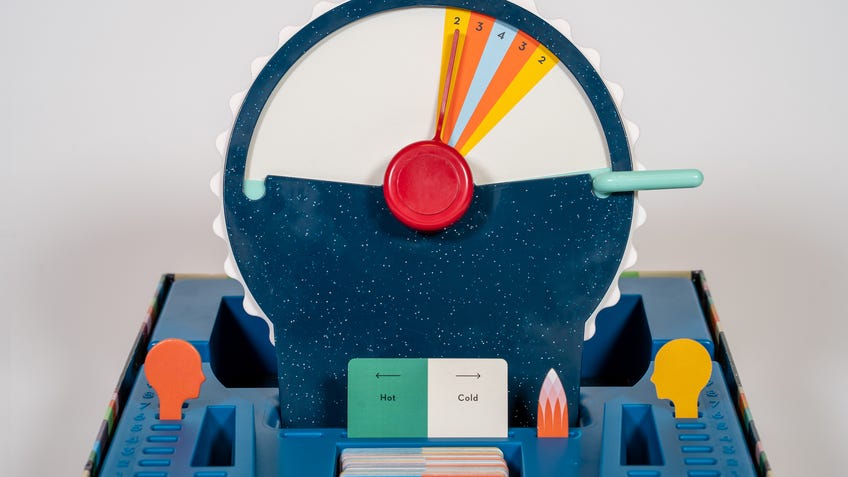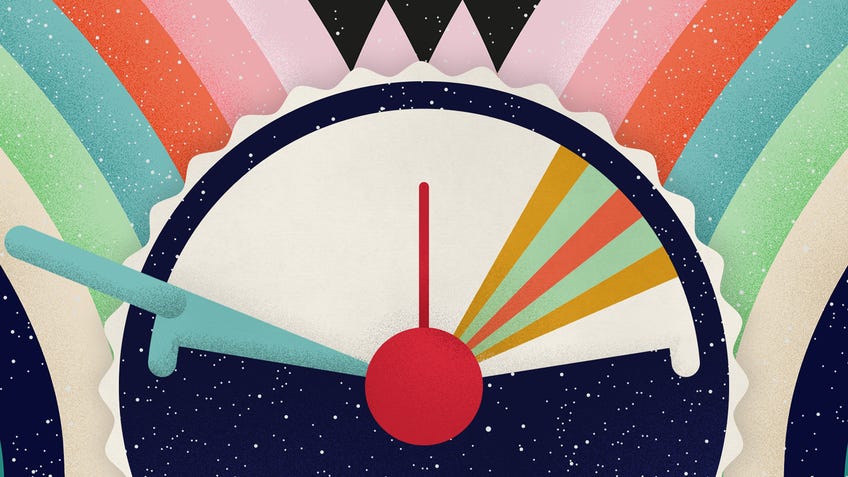Wavelength board game review - the best party game since Codenames
Dialled in.
There's this feeling in Wavelength, a couple of rounds in, where you riff off your teammate's clue and land right on the mark. The result is this surge of electricity in your skull that warms your entire being. It's a second of perfection where you feel this fleeting yet substantial spark of telepathy as you crawl into another person's brain matter and have a moment. That's the power of a marvellous game.
Wavelength is a party board game. You know the drill; you gather up a group of friends - the more the better with this one - and split into two teams as shouts of petty insults and gentle ribbing form the soundtrack. Alcohol may or may not be involved, but laughter and a constant stream of “oohs” and “aahs” flow forth as players miss a guess by a hair or land perfectly in the scoring zone.
This is kind of a weird one. It hews closest to the ubiquitous Codenames, that ever-popular word-guessing game held up as one of the best board games of recent years that can now be found in every shop and home. One team has a go, a member offering a clue to the rest of their chums and hoping to lead them true. But I have to explain the process of how this works because it's not so simple.

First there's this big contraption. It's a plastic wheel on a post that you sit upright in the bottom of the box. Take a look at one of the pictures because it's a dandy. You give the wheel a spin or two and then open this little viewing slot. You see, the face of the wheel is purposely obscured, hiding the location of a scoring wedge that the guessers are not allowed to view.
Think of it like a speedometer. With a random spin the bullseye may be at 20mph or it may be far to the right at 120. So let's say it's at 30, halfway between the centre and zero.
Now the clue-giver pulls a card which gives two extremes at opposite ends of the spectrum. Say you've drawn “pizza toppings”. To the far left would be the worst toppings and to the far right would be the best ones. Now you must think of a clue to fit the target of 30 for this hypothetical situation.
Since it's leaning towards pretty negative maybe you throw something out there like “anchovies”. Or maybe that would be the worst possible topping and it would be too far. Perhaps you know Susie on your team dislikes pineapple on pizza so you suggest that. Maybe you don't.
Nailing the exact position of the scoring wedge is a remarkable feeling.
This is all subjective and you need to worm into your teammates’ brains to be clever. Thinking of that perfect clue can take a while, unfortunately. This is the big downside to Codenames and it's still present here. One person is sitting quietly with their brow furrowed while the rest are maybe twiddling their thumbs and just waiting. Hopefully you've seen an interesting movie or read a good book lately and can share your unsolicited thoughts to pass the minutes.
The element of downtime, for both teams, is the biggest criticism of Wavelength. It's interesting because the more recent party board game hit Just One solved this problem by having only a single player waiting while the rest of the table thought of individual clues; here it does feel like we're moving backwards a bit. Still, the payout is worth the small pause so keep your head up and keep at it. Besides, without that moment of respite you'd never know that Jim hated The Lighthouse and therefore has poor taste in film.
Finally you've thought of it, you have your clue: “pineapple” it is. Susie immediately globs on and leads the conversation. This right here is the second-best moment; the chatter between teammates and often dissenting opinions leads to wonderful conversations. Sure, maybe pizza toppings aren't too exciting or spicy. But what if the card has “good person” and “bad person” at the extremes and your teammate offers the clue “Boris Johnson”? With hundreds of cards and all kinds of topics, the conversation sprouts off in interesting directions and careful thought breaks into wild laughter.

This is also where the game diverges from Codenames. In that game, the clues are very specific and the discussion is around context. Often the words they are pointing out will be obvious unless they make a more risky play to target a large number of cards. Wavelength feels like this risky play every single round. Nothing is clean or black and white as the clues are not grounded in any sense of objectivity. The thought process of deciphering this information always leads to a human puzzle of entanglement. It’s not a conundrum of creative linkage but one of careful discernment.
Back to the clue. Once the hint is given, your team positions a little dial so that it's pointing to where they think the target is. "Pineapple is pretty awful," says Susie, "but it's clearly not the worst topping."
Discussion is eventually wrapped as opinions are settled and everyone holds their breath. The panel covering the wheel is opened in a moment of dramatic tension.
When land exactly on the same page it truly feels as though you're mentally linking up in a bit of instinctual telepathy.
Nailing the exact position of the scoring wedge is a remarkable feeling. It's an emotional moment that gives way to high-fives and overt celebration. When you connect with a friend and land exactly on the same page it truly feels as though you're mentally linking up in a bit of instinctual telepathy.
This is the game's second strong comparison, which is with The Mind. This is not altogether surprising considering Wolfgang Warsch, co-designer of Wavelength, was the one behind 2018’s brilliant card game. (Warsch is joined on Wavelength by Alex Hague and Justin Vickers, creators of party favourite Monikers.) The Mind was almost more of an experience than game, a co-operative challenge of quietly placing numbered cards in ascending order without speaking that offered the very unique trick of convincing participants they were communicating with their brains as opposed to their voice. Wavelength plays in the same cool waters, offering an inspiring take on similar principles while trading out quiet contemplation for vocal discussion. It's more overtly ‘party’ in the sense that the fun is easily noticed by onlookers.
Now that you have the whole picture you can see the flow of play is a little confusing at first. This is mostly due to Wavelength’s unique setup and that big contraption not making immediate sense. Once a turn or so has passed everyone will have their "Aha!" moment and the magic will happen.
Wavelength may not be the next Codenames in terms of mainstream success, but it deserves every inch of it. It has a bit of an uphill battle in that you really want a minimum of six players, otherwise you will miss out on that crucial discussion concerning clue interpretation. This conversation and the resulting payout is what makes this game so appealing. Those who can find the appropriate number of warm bodies will be rewarded with unmistakable brilliance.

